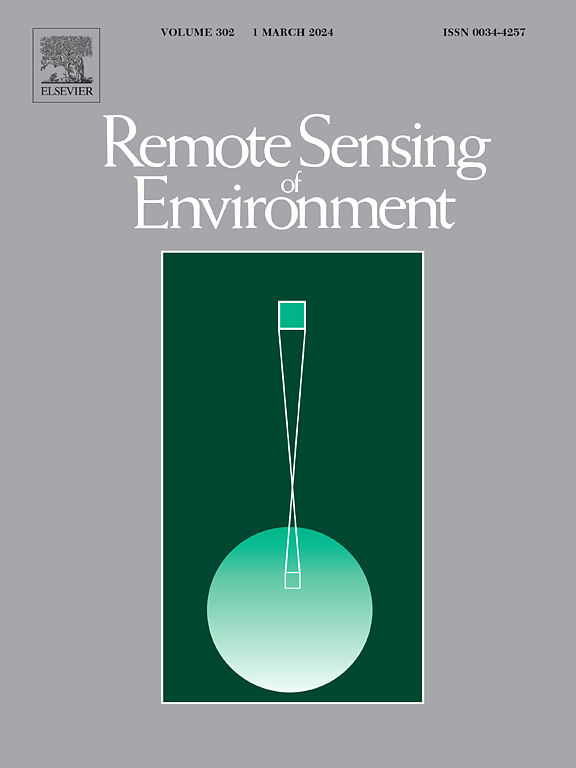Using UAV images and deep learning to enhance the mapping of deadwood in boreal forests
IF 11.1
1区 地球科学
Q1 ENVIRONMENTAL SCIENCES
引用次数: 0
Abstract
Deadwood and decaying wood are the most important components for the biodiversity of boreal forests, and around a quarter of all flora and fauna in Finnish forests depend on them, with third of these species being red-listed. However, there is a severe lack of stand-level deadwood data in Finland, as the operational inventories either focus on the large-scale estimates or omit deadwood altogether. Unoccupied Aerial Vehicles (UAVs) are a cost-effective method for remotely mapping small objects, such as fallen deadwood, over compartment-level areas, as even the most spatially accurate commercial satellites and aerial photography provide 30 cm ground sampling distance, compared to less than 5 cm that is easily achievable with UAVs.
In this study, we utilized YOLOv8 by Ultralytics for detecting and segmenting standing and fallen deadwood instances from RGB UAV imagery. Our study consists of two geographically distinct study areas in Finland, Hiidenportti National Park and Evo. We manually annotated around 13 800 deadwood instances to be used as the training and validation data for the instance segmentation models. These annotations were also compared to field-measured deadwood data from Hiidenportti to assess the extent on how much of the deadwood can even be seen from UAV imagery. We also compared how the models perform on another area than from which its training dataset was from, and whether adding data from another areas to the training dataset improves the performance compared to training only with images from one location.
The best performing model achieved test set mask mAP50 score of 0.682 for Hiidenportti and 0.651 for Sudenpesänkangas datasets. For both areas, including imagery from the another area improved the instance segmentation metrics, whereas using data only from another site to train the models produced significantly worse results. While methods utilizing UAV imagery cannot completely replace traditional field work, they should still be considered as an additional tool for field campaigns.
利用无人机图像和深度学习增强北方森林枯木制图
枯木和腐木是北方森林生物多样性最重要的组成部分,芬兰森林中大约四分之一的动植物依赖于枯木和腐木,其中三分之一的物种被列入红色名录。然而,芬兰严重缺乏林分水平的枯木数据,因为业务清单要么侧重于大规模估计,要么完全忽略了枯木。无人驾驶飞行器(uav)是一种具有成本效益的方法,用于远程测绘小物体,如落在舱室水平区域的枯木,因为即使是空间精度最高的商业卫星和航空摄影也提供30厘米的地面采样距离,而无人机可以轻松实现不到5厘米的采样距离。在本研究中,我们利用Ultralytics的YOLOv8从RGB无人机图像中检测和分割直立和掉落的枯木实例。我们的研究包括芬兰两个地理上截然不同的研究区域,Hiidenportti国家公园和Evo。我们手动标注了大约13800个deadwood实例,作为实例分割模型的训练和验证数据。这些注释也与Hiidenportti现场测量的枯木数据进行了比较,以评估从无人机图像中可以看到多少枯木。我们还比较了模型在另一个区域的表现,而不是其训练数据集的来源,以及与仅使用来自一个位置的图像进行训练相比,将来自另一个区域的数据添加到训练数据集中是否会提高性能。表现最好的模型在Hiidenportti和Sudenpesänkangas数据集上的测试集掩码mAP50得分分别为0.682和0.651。对于这两个区域,包括来自另一个区域的图像可以改善实例分割指标,而仅使用来自另一个站点的数据来训练模型会产生明显更差的结果。虽然利用无人机图像的方法不能完全取代传统的野外工作,但它们仍然应该被视为野外战役的额外工具。
本文章由计算机程序翻译,如有差异,请以英文原文为准。
求助全文
约1分钟内获得全文
求助全文
来源期刊

Remote Sensing of Environment
环境科学-成像科学与照相技术
CiteScore
25.10
自引率
8.90%
发文量
455
审稿时长
53 days
期刊介绍:
Remote Sensing of Environment (RSE) serves the Earth observation community by disseminating results on the theory, science, applications, and technology that contribute to advancing the field of remote sensing. With a thoroughly interdisciplinary approach, RSE encompasses terrestrial, oceanic, and atmospheric sensing.
The journal emphasizes biophysical and quantitative approaches to remote sensing at local to global scales, covering a diverse range of applications and techniques.
RSE serves as a vital platform for the exchange of knowledge and advancements in the dynamic field of remote sensing.
 求助内容:
求助内容: 应助结果提醒方式:
应助结果提醒方式:


